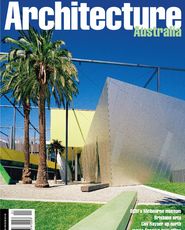The Australian building and construction industry is renowned for its ingenuity, invention and resourcefulness. However, recent research suggests that IT penetration in the industry is very low, compared with our global competitors. To date, most firms have implemented the basic automation of typical business processes, such as e-mail, accounting and CAD. The real changes and benefits will only be realised when we extend IT into the fundamental way we do business. Strategic exploitation of IT is possible in all key processes of the construction business. Specifically, the architectural profession has an opportunity to reposition itself in the supply chain and increase its value to the industry. The aim of this article is to clarify the vocabulary being generated by IT, in order to promote a discussion on the changes that are imminent. The main ideas discussed are alliance structures, project webs, 3D models and IFCs (Industry Foundation Classes).
In many other industries strategic alliances have become central to competitive success. In the construction industry they offer an alternative to competitive tendering, inefficiency, and the current adversarial situation.
The Acton Peninsula project in Canberra is a test case for an alliance-based procurement method. Acton is being carefully monitored to determine objective benchmarks for the benefits, or otherwise, of the idea. Due for completion in March 2001, the results will soon be on the table.
What is the difference between alliancing and design and construct or partnering? The key is in the risk management of the project and the IT that facilitates the process. Firstly all key players are on board from the beginning, sharing common goals and with all members working for 11 what's best for the project" The client sits at the table with the consultants, including the architect, contractor, engineers and, ideally, the facility manager and operators. The alliance determines from the beginning the outcomes that together they are going to achieve. Budget, performance, program, brief, integrity, quality, and so on are defined and performance criteria established. Shared rewards and penalties are agreed, and the process begins.
An essential component to establish trust, direction and ownership of the alliance is the accessibility, transparency, and quality of the information. A project web is the vehicle that allows the information to be easily accessible to all parties. In simple terms it is a web site that manage the information (CAD, brief, specifications, costs etc) and facilitates and records all communications (e-mails, transmittals, meeting minutes, proformas, etc.).
Passwords are issued to enable and limit access. These sites exist today. Some are private and available only to the companies that made them; others are available to any project for a marginal cost. The concept of using a File Transfer Protocol (FTP) enabled web site as a "dropbox" for distributing drawings etc is easily accepted. The value is in the transfer of responsibility from sender to receiver for ensuring the latest information. All the information on the site is current. Interested parties download relevant documents as and when they need them. This enables not only the processing of information, but also the efficient management of a project that changes daily. The process becomes less a case of managing objectives, contracts, and commitments, and more one of tracking a moving target and maintaining options that create value.
The dropbox is the first step into a project web. The next will be the advent of ITC rated software, 3D modelling and broadband communication.
This will signal the most significant change to the way we presently do business. IFCs are the key deliverable from the International Alliance for Interoperability (IAI). The IAI is a non-profit alliance whose mission is to define, promote and publish a specification for sharing data throughout the project lifecycle, globally, across disciplines and across technical applications. Interoperability specifically refers to the seamless interchange of "project data" between different software products developed by different vendors. The main focus is that 11 project data" is never lost in the interchange process, or between the different stages in the project's lifecycle.
The IAI produces process models and object models. A process model describes the tasks that are undertaken within a defined business activity and shows how and what information needs to be communicated between tasks.
The 1Al's process models map the four phases of a project's life: feasibility, design, construction and operation. An object model is a representation of the information, content and structure which needs to be exchanged or shared. This complexity is not a concern as the purpose of the models is to inform the software manufacturers of the agreed formats. The end result (depending on the uptake and support) for architects, engineers and contractors is that all the different software we use (Autocad, Archicad, Microstation, Timberline, Primavera etc) will be interoperable and all players in the industry will follow similar processes.
The basis of the interoperability initiative is that data from one package to another is seamlessly transferred, ensuring the intended information format is the same at both ends. IFCs standardise format and structure. For example, the IFC model for "a door" sets all the parameters necessary to describe the door. The height, width, material, finish, hardware, head, jamb, etc are all given agreed fields. The architect fills out the fields their project requires. The door suppliers are using the same fields, so they can connect to the data model and automatically update their information and therefore their supply cost.
The core ingredient of change lies within the above description. The IFCs will permit quantities and specifications of materials and products to be transferred to, and accessed by, all parties. The IFCs are embedded in the 3D model (the core database), which is generally created and maintained by the architect. The 3D model is concerned with the whole life cycle. It links with planning and cost modelling, and allows the utilisation and manipulation of data during the design, construction and operational phases by all parties involved in the project - simultaneously. The value of the 3D model, under this process, is increased and maintained throughout the life of the building It is no longer just a marketing/presentation tool, rather it becomes the central control document. This presents a key opportunity to reposition the architectural profession. By maintaining control of the information we revalue our position in the supply chain. With the alliance structure replacing tendering there is no longer a point of transfer of the 11 ownership" of the information to the contractor. The architect remains central throughout, and the model links directly to the suppliers, the site, and all other users.
This key opportunity is dependent on technologies that are still in their infancy. It could be argued that these ideas are interdependent.
Alliances may only be possible once web-based management is general accepted and IFCs and 3D modelling permit the effective transfer and management of information. Given support and dependant on uptake IFCs may be broadly adopted by the end of 2003, and many practices are already using 3D programs for documentation, and 2D programs such as Autocad have 3D upgrades available. The path of change is always difficult to predict, but our industry faces one certainty: IT will revolutionise our practice and our practices. Currently both webs and alliances are being researched and tested with case studies in our industry This is in order to gather objective information that can be used to push the industry in this direction. Currently in our industry there is a prevailing distrust of IT and a resistance to change. We can no longer avoid this issue; we have to face the reality that it is already happening. There are risks, but there are also opportunities which are being seriously considered by other members of the industry, especially the contractors who could possibly be disempowered by the changes.
It is easy to accept that there is great benefit to be gained from IT. The problem is knowing where to start and how far, and how quickly to go. We need to review our core competencies, and objectively and strategically position ourselves for the change. This is not limited to the bigger firms: all practices and all practitioners need to move. That doesn't mean go out and buy bigger computers and expensive software. Indeed, with the scope of the change coming it is probably best to hold the upgrades and concentrate on developing basic skills in current programs and equipment. Most people using CAD are only utilising a small percentage of the program's current capabilities. We need to direct our efforts to training and understanding the changes to our core processes, for example the difference between how we used to document and design, and the possibilities that will soon be available.
We need to extend the interaction into all levels in the office, especially senior management, who will have to understand IT potentialities in order to direct the restructuring of the business. Transforming our industry and developing the relationships and processes necessary is the end game. The opportunity exists for architects to lead this transformation.
Source

Archive
Published online: 1 Jan 2001
Words:
Andrew Gutteridge
Issue
Architecture Australia, January 2001














